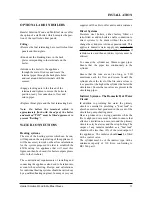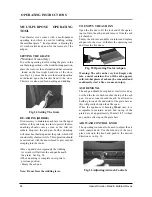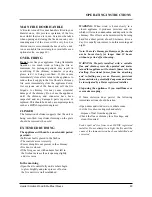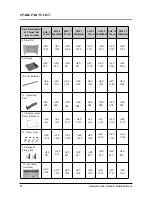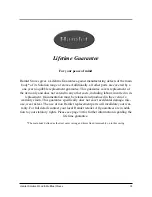
20
Hamlet Solution Wood & Multifuel Stoves
SERVICING & MAINTENANCE
CLEANING
INTERNAL SURFACES
IMPORTANT -
Under some circumstances soot can quickly build
up on the throat plate and adjacent areas. The throat
plate should be removed and checked monthly, and
any debris stripped off. Similarly, clean the upper
surface of the firebox. Refer to page 16 for instruc-
tions on the throat plate removal / inspections.
OUTER FINISH
The outside finish of the appliance is a durable high
temperature paint. It is best cleaned by brushing
down with a clean shoe brush. Do not allow
moisture to remain on the appliance whilst cold or
surface rust may form.
The high temperature paint should not require
attention for some time, depending on use. The
hotter the fire burns the sooner repainting will be
necessary. Aerosol tins of paint are available for
complete refurbishing. Before repainting make sure
that the fire is out and is cold.
•Remove the door glass.
•Lightly wire brush, or rub with wire wool, the
body of the appliance to remove any loose paint
powder.
•Mask or remove items such as brass work.
•Any adjacent brickwork, mantelpiece, hearth,
etc., should be carefully masked for quite a
distance around the appliance. (this precaution is
to prevent discolouration of the surrounding brick
work, wallpaper etc).
Re-spray in a well-ventilated area - avoid breathing
the vapour. Refer to safety instructions on paint
cans.
•When the paint is dry refit door glass and any
other parts previously removed.
•Leave the appliance for eight hours before
re-lighting.
•Burn slowly for the first four hours, then build up
heat gradually to cure the paint.
Note: Use only genuine Hamlet Stoves touch-up
spray as some paints interact. This could ruin the
finish and invalidate the guarantee.
DOOR GLASS
The door glass should remain clear during normal
daytime burning. However under certain conditions-such
as burning at a low rate with damp wood, or overnight
burning, the glass may become somewhat blackened. To
remedy this, operate the appliance at a fast rate.
Alternatively when the stove is cold open the door and
clean the inside face of the glass with a damp cloth or
with glass cleaner (available from fire stockists). Apiece
of cloth moistened with vinegar and dipped in wood ash
-
not coal ash
- will provide a good soft scourer to
remove the soot without scratching the glass.
CHIMNEY SWEEPING
Sweeping should be carried out with an appropriate
sized bristle brush and rods to suit chimney size and
type. As with all appliances regular sweeping of the flue
is essential to avoid the danger of blockage and the
escape of poisonous fumes. Access for cleaning should
also be incorporated in the chimney (e.g. soot door or
access through register plate).
Any existing chimney should be swept prior to
installation of the appliance, and swept again a
second time
within one month
of regular use after
installation to establish frequency of sweeping
required. This should be done by a competent
person such as a NACS chimney engineer who will
provide a Certificate of Chimney Sweeping.
Sweep the whole flue way, including the outlet, at
least twice per burning season. It is important that
the flue ways, flue pipe and chimney be cleaned
prior to lighting the fire after a prolonged
shut-down period.
If any damage or doubt over the flue or chimney
exists,
DO NOT
use the appliance until the chim-
ney and connector have been inspected and any
damaged parts repaired or replaced. This should be
done by a competent person such as a HETAS reg-
istered engineer.












